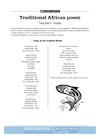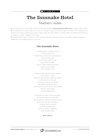What a performance!
Add to My Folder
Perk up poetry lessons with sound effects and action ideas from Brian Moses

For centuries, poetry has been read aloud, it has been sung or chanted, sometimes danced to and set to a musical background. Poetry is an oral art form – it comes to life when it is read aloud and can be an effective tool in any classroom. Plus, children love the fact that they can experiment with words and ideas, and can be as imaginative and as creative as they like. The activities on the following pages aim to give some suggestions as to how to perform poems and how best to include sound effects and action.
Getting started
In the classroom it will take time and effort to prepare a poem to read aloud, but is well worth all the hard work! Choose a poem and read it aloud to the class. Ask them to comment on what they have heard. Do they think it can it be read in a variety of ways? If so, perform it using different methods and discuss which is the best interpretation.
Before the children perform a poem, there a number of things that need to be considered:
- How many voices will be needed? A poem with choruses is often effectively read with one voice taking the verses and several voices joining in on the chorus.
- How should the poem be read? Will some parts need to be shouted out or whispered? Explore the tone and the subject matter.
- Pay attention to other areas, such as clarity of diction, the right emphasis and speed of reading. Does anyone need to adopt an accent? Do children need to learn the words by heart?
- Consider whether actions or sound effects could help the performance.
- Can the use of percussion instruments help to establish a rhythm? Download the interactive poster and sound file of the poem ‘Shopping Trolley’ from www.scholastic.co.uk/magazines/activity sheets-jed.htm and let the children listen to the drumbeats on the recital. How effective are they in maintaining the rhythm? If a poem doesn’t rhyme then some kind of mood music may be more effective. Check out the school’s music room for xylophones, bells, shakers, and so on.
- Does anyone play keyboards or work with music programs on the computer? Perhaps a backing track could be composed and played in the background while the words are being read aloud.
- Do some readers need to wear costumes to give the piece visual appeal? Do you need any special lighting? A spooky piece, for example, could be performed with the lights turned off and the blinds drawn down.
Already a member? Sign in below.
Published 10 June 2008
Reviews
You need to be signed in to place a review.



